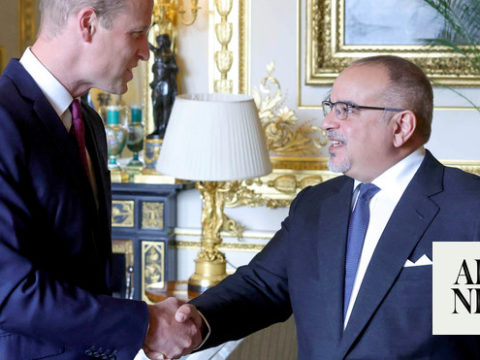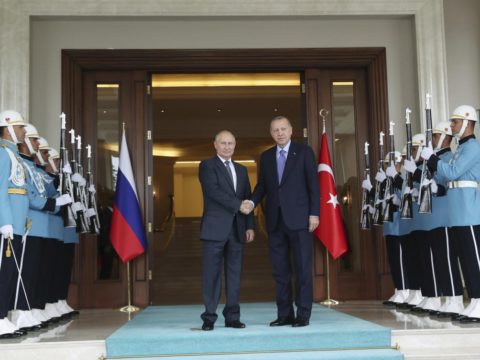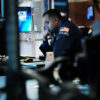
BEIRUT: Five stalls selling newspapers and books on the sidewalks of Beirut’s Hamra Street are all that remain of a series of similar stalls that had defined this historic commercial street for decades.
Lebanon’s years-long economic crisis has brought chaos, destitution, and begging to Hamra Street, once frequented by renowned international artists during its golden years. It used to host the latest global films in its cinemas, and its cafés buzzed with discussions that covered topics ranging from Beirut to Vietnam.
As stall owner Naim Mohammed Saleh put it: “The street’s identity has changed. Its inhabitants have deserted it, and its visitors have vanished.”
He paused briefly to sell a newspaper to a man in his sixties. “These are the ones who read print newspapers: the generation of the Fifties and Sixties,” he continued. “But the youth? No. They have moved on to the screens of their phones, flipping through websites, with all the news at their fingertips. As for the books I arrange daily next to this café — my corner since I decided in 1978 to follow in my father’s footsteps — no one buys them.”
Saleh, who comes from the southern town of Tebnine, moved to Beirut with his relatives — as so many young people from the villages in the south did — in the 1960s, seeking a better life in the city.
He and his brothers used to help their father distribute newspapers in residential buildings along Hamra Street. When he got married in the 1970s, Saleh took a corner on the street adjacent to Café de Paris and continued as a vendor, earning money to educate his children at the American University of Beirut. He himself had attended the Lebanese University, gaining a degree in business administration.
Saleh said: “The most famous street in Lebanon, the Arab world, and the entire globe, Hamra Street was frequented by tourists, politicians, artists, and intellectuals from every corner. Presidents Amine Gemayel and Bashir Gemayel practiced law in Amine Sinno’s law firm here and engaged in discussions at the Horse Shoe Café that lasted for hours. During the premiere of “Gone with the Wind,” the audience stayed in the cinema until 2:15 a.m., leaving utterly amazed. They were dressed in clothes from the most prestigious fashion houses, purchased from this very street. Fayrouz showcased her plays here, as did Adel Imam, and Dalida performed her songs right here. People walked shoulder-to-shoulder; such was the bustling nature of the street.”
With the outbreak of civil war in 1975, Hamra Street was associated with the struggle for the Palestinian cause and other Arab issues. A trace of intellectual and sectarian diversity endured.
“As the shelling intensified, the street emptied of its patrons, but with each cease-fire it returned to its crowded state. Those who left the commercial center in Downtown Beirut, which had turned into the frontline, shifted to Hamra Street,” Saleh explained.
He noted that “more than one book printed in Beirut and sold at our stands caused upheavals, from books about the Gulf War to (Egyptian spy) Raafat Al-Haggan’s book, and even the books of (Algerian writer) Ahlam Mosteghanemi and (celebrity chef) Chef Ramzi’s cookbook.”
He continued: “On the day when the German chief investigator Detlev Mehlis published his report on the assassination of former Prime Minister Rafic Hariri, I sold around 4,000 copies of the newspaper in less than an hour. Today, if I sell 10 copies of a print newspaper in a day, it’s an achievement.”
Hamra Street survived the civil war but not the major transformations that came after. Most of its theaters closed down — only Al-Madina survived. The cinemas gradually disappeared, followed by the bookshops. Cafés turned into fast-food restaurants.
“During the COVID-19 pandemic, most of my sales were crossword magazines and magazines for children,” Saleh said. “With the economic collapse in 2019, people’s concerns have been reduced to securing food, shelter, paying for their children’s schooling, and ensuring a stable electricity supply. The street entered a phase of darkness and emptiness. Tourists today are groups of Iraqis accompanying their relatives for operations at the American University Hospital, and Syrians. We miss Gulf tourists, especially Saudis, who were avid readers. This is not (true of) Iraqis or even Iranians. When they come to Beirut and Hamra Street, you can tell their interest in books is close to zero.”
According to Saleh, “Before the economic crisis, I used to sell between 40 and 50 books per month. Now, the price of a book is no less than one million Lebanese pounds — equivalent to $10 — which makes Lebanese reluctant to buy books. Today, I only sell two books per month.”
The whole street is no longer the upmarket, thriving commercial hub it used to be, Saleh explained. “The shoes displayed in shop windows are now of Asian make, whereas they used to be Italian and French. Many signs can be spotted on storefronts announcing ongoing clearance sales on clothing. They have been there since the beginning of the crisis, and the clearance hasn’t ended yet,” he said.
“The phenomenon of begging and homelessness is what visitors to Hamra Street complain about most. Stores that used to open until 7 p.m. now close before 4 p.m. because the evening crowd is different from the daytime crowd. Before noon, employees, doctors, patients, university students, and those who work in banks or institutions that have survived in Hamra, visit,” he continued.
In some buildings, though, offices of civil associations thrive. “It’s true that they infuse some life into the street, but their work is limited to assisting those in need, nothing more,” Saleh said. “And that doesn’t restore Hamra Street to its past glory and splendor.”














